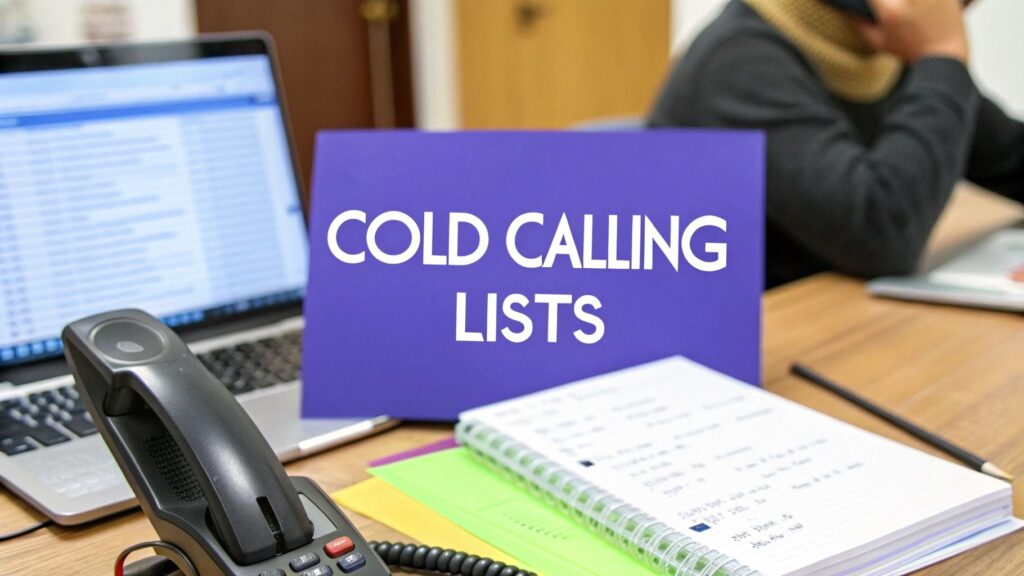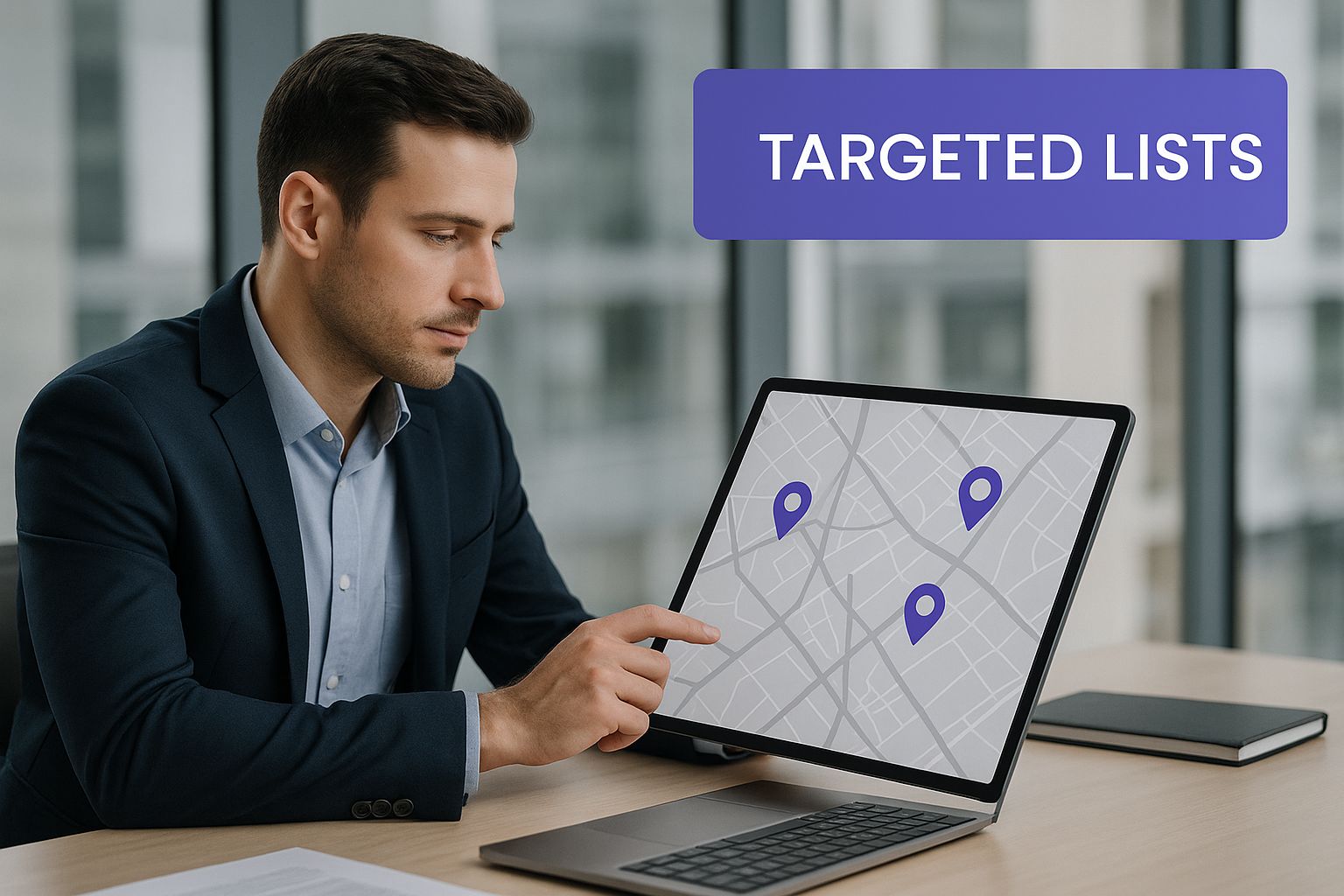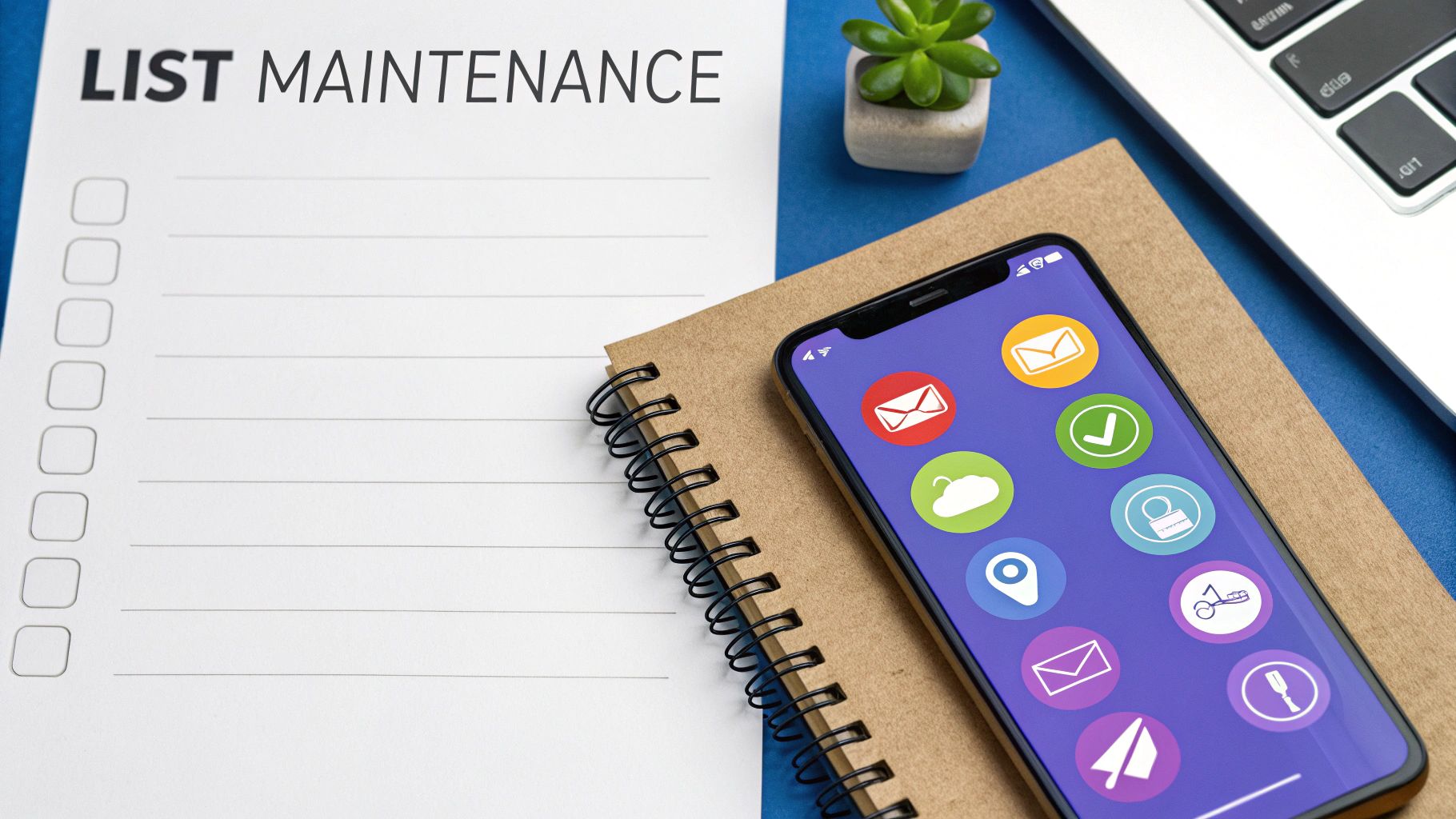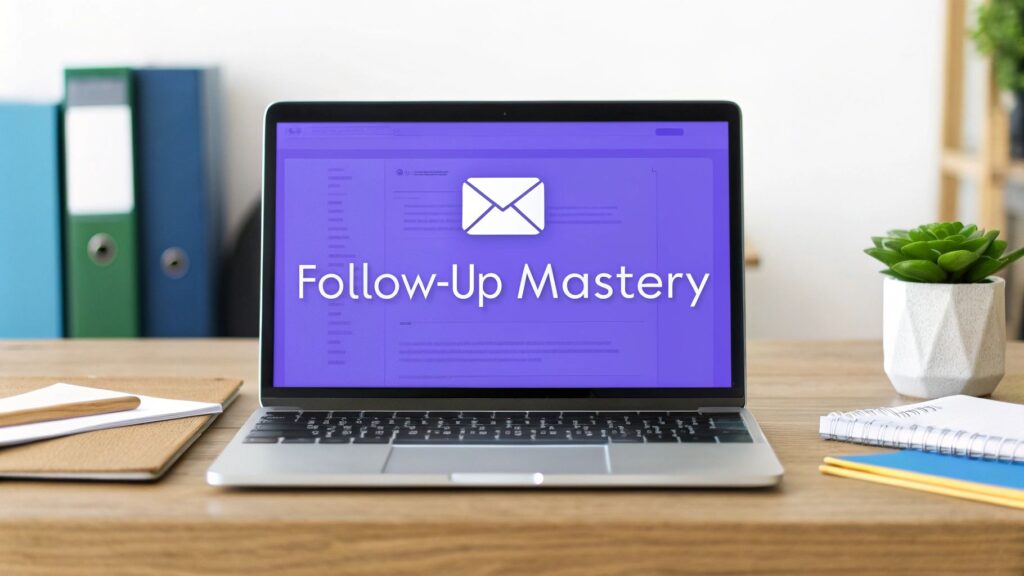Build Cold Calling Lists That Actually Convert

A great cold calling list is more than just a spreadsheet full of names and numbers. Think of it as a strategic asset, meticulously built on accurate data and a genuine understanding of who you're trying to reach. It’s the bedrock of any successful outreach campaign, and frankly, it's what separates the pros from the teams that just spin their wheels.
Why Most Cold Calling Lists Fail
Let’s be real for a moment. Most cold calls are dead on arrival, and it often has nothing to do with the script or the person making the call. The real culprit is the list. A bad list is like trying to build a house on a swamp—it doesn't matter how great your blueprints are; the whole thing is going to sink.
The damage goes beyond one bad call. When your reps are constantly hitting dead ends—wrong numbers, people who left the company six months ago—it kills momentum and morale across the entire team. In fact, studies show that sales reps spend up to 40% of their time just looking for someone to call, a direct result of poor list quality.
The Problem of Outdated Data
Contact info has a shockingly short shelf life. On average, B2B data decays at a rate of 22.5% per year. This means that after just one year, nearly a quarter of your list could be inaccurate. People switch jobs, companies restructure, and phone numbers get disconnected or reassigned. A list that was solid just a few months ago can quickly become a minefield of bad data. Every wrong number is a waste of time and a hit to your team's motivation, which directly impacts your bottom line.
A flawed list doesn't just waste time—it actively damages your brand. Every call to the wrong person or with outdated information signals a lack of preparation and respect for the prospect's time, making a poor first impression that's hard to recover from.
Generic Targeting and Its Consequences
The other classic mistake is the "spray and pray" approach. If your list is just a generic data dump of companies within a broad industry, you're setting yourself up for failure. A pitch crafted for a nimble tech startup is going to land with a thud when you deliver it to a logistics manager at a Fortune 500 company. That lack of personalization immediately flags you as spam and earns a quick dial tone. For example, telling a logistics manager about "agile development cycles" won't resonate; they're worried about supply chain optimization and fuel costs.
This is more critical now than ever. The average success rate for cold calls recently plummeted from 4.82% to about half that in just one year. That staggering drop means your team has to make twice as many calls just to get the same results, making the quality of every single lead absolutely paramount.
Getting a handle on these common failures is the first step. To get past these hurdles, you need to lean into proven tactics. For a deeper dive, check out these cold calling best practices to sharpen your strategy. You can also dig into our guide on cold calling statistics to see how the numbers can inform a smarter approach.
Sourcing and Building Your Prospect Universe
A great cold calling list isn't something you just find; it's something you build. Think of your "prospect universe" as the total pool of everyone who could be a great customer. The first real step in any successful campaign is figuring out how to source them. Simply buying a generic list and dialing for dollars is a fast track to burnout and dismal results.
Instead, the best agencies use a mix of strategies to keep a steady flow of fresh, high-quality prospects coming in. The core idea is a lot like learning how to build an email list that actually grows your business—it's all about quality over quantity and creating a sustainable asset.
Let's dig into the three main ways you can build out your prospect list.
Buying Cold Calling Lists from Reputable Vendors
Let's be honest, buying a list is the quickest way to get names and numbers. If you're a new agency or just need to get a campaign off the ground fast, it can give you the volume you need right away. But this speed comes with a huge catch.
The market is an absolute minefield of data brokers selling junk lists. We're talking about outdated contacts, wrong numbers, and even illegally scraped data that can land you in hot water. A bad list doesn't just waste time; it kills morale. For instance, buying a cheap list of 10,000 "marketing managers" might yield an 80% bounce rate on emails and a 50% disconnected rate on phone numbers, wasting days of your team's time.
To avoid getting burned, you have to do your homework on any vendor.
- Demand a Sample: Never buy a list blind. A good provider will have no problem giving you a small sample of 50-100 contacts to test. Call a few numbers, verify some emails with a tool like Hunter.io, and look up a few people on LinkedIn. See if the data is actually real.
- Ask Where the Data Comes From: Ask them point-blank: "How do you get your data, and how often do you update it?" If you get a fuzzy, vague answer like "proprietary sources," run. Look for concrete answers like "We verify our database quarterly using public records and automated crawlers."
- Confirm Compliance: This is non-negotiable. Make sure the vendor follows regulations like GDPR in Europe and CCPA in California. The last thing you need is a legal headache because you bought a shady list.
For more on finding the right contacts, our guide on building a business lead list can give you some extra pointers. Buying a list can be a decent starting point to test a new market, but it should never be your only source of leads.
Comparison of List Sourcing Methods
Choosing how to source your prospect data is a strategic decision. This table breaks down the main approaches to help you decide what's best for your agency based on your budget, timeline, and goals.
| Method | Best For | Average Cost | Time Investment | Data Quality |
|---|---|---|---|---|
| Buying Lists | Speed and volume; quickly testing new markets or messaging. | $ (Varies widely, from $0.10 to $2 per contact) | Low | Variable to Poor |
| Building Manually | High-quality, hyper-targeted campaigns where precision is key. | $$ (Tools like LinkedIn Sales Navigator at ~$99/mo) | High | Excellent |
| Using Intent Data | Prioritizing outreach to the hottest, most active prospects. | $$$ (Subscription-based platforms like Bombora, starting at $25k+/yr) | Medium | Very High |
Each method has its place. A new agency might start by buying a small list for immediate activity while dedicating time to building a high-quality manual list for the long term.
Building Lists Manually with Precision Tools
If you want the absolute best quality, build your list yourself. It takes more time and effort upfront, there's no doubt about it. But the payoff is a clean, perfectly targeted list where every single contact fits your ideal customer profile (ICP). You have total control.
For this, LinkedIn Sales Navigator is your best friend. It lets you slice and dice LinkedIn's entire network with incredible precision. You can zero in on people by job title, company size, industry, location—even down to keywords they've used in their profile.
This is exactly what I mean. The filters in Sales Navigator let you get incredibly specific.

Imagine you're targeting SaaS companies. You could instantly build a list of every "VP of Marketing" at companies with 51-200 employees in North America that have "increased headcount by 10% in the last year." That's a powerful, highly relevant list you just created from scratch.
The real secret to building a list manually isn't just the data—it's the context you pick up along the way. When you research each person, you find little nuggets of gold: a recent promotion, a company announcement, a post they commented on. That's what turns a cold call into a relevant conversation.
Leveraging Intent Data for Timely Outreach
Now we're getting into the advanced stuff. The ultimate strategy is using intent data—behavioral signals that tell you a company is actively looking for a solution like yours right now. Calling someone who's already in the buying cycle is a total game-changer. Sales teams using intent data can see a 2x increase in their conversion rates.
Intent data comes from a few places:
- First-Party Data: This is gold. It’s the activity on your own website, like people visiting your pricing page three times in a week or downloading a specific case study. These are your hottest leads, period.
- Third-Party Data: These are services that track research activity across the web. They can tell you when people from your target accounts are reading articles about "best CRM for small business" or checking out your competitors' G2 reviews.
Think about it. You get an alert that three people from a target company just read a blog post on "Improving B2B Lead Generation." If you sell lead gen services, that's your cue to pick up the phone. It's the difference between knocking on random doors and knocking on the door of someone who just put up a "Help Wanted" sign.
Honestly, a hybrid approach works best for most agencies. You might buy a small list to get the ball rolling, build a super-targeted list in the background with Sales Navigator, and then use intent data to know who to call first. This combo gives you both immediate activity and long-term, high-quality pipeline.
Turning Raw Data Into Qualified Leads

Let's be honest. A fresh list of names and numbers isn't an asset; it's just a starting point. Think of it as raw ore. Your real job is to refine that massive chunk of data into a much smaller, far more potent list of genuinely qualified leads. This is where the hard work of building effective cold calling lists truly begins.
If you skip this step, your sales team is essentially dialing in the dark. They'll burn through valuable hours chasing contacts who are irrelevant, have left their roles, or are simply the wrong fit for what you offer. The goal here is to transform a high-volume, low-certainty list into a high-precision list of probable customers.
The Multi-Step Validation Process
Treating your data well isn't a one-and-done task; it’s a constant discipline. It requires a systematic process of cleaning, verifying, and enriching your data to make sure every single call has the highest possible chance of connecting with the right person.
This has never been more critical. Getting someone to even pick up the phone is a monumental challenge these days. In the United States, a staggering 87% of people now regularly ignore calls from unknown numbers, and you can thank the flood of scam calls for that. To make it even tougher, about 80% of cold calls go straight to voicemail, and the B2B response rate for those messages is less than 5%.
These numbers aren't meant to be discouraging—they're a reality check on why a meticulously qualified list is your only real advantage.
Slash Bounce Rates with Email Verification
Before you do anything else, you have to verify your contact data. Nothing kills a campaign's momentum faster than a high email bounce rate or a string of disconnected phone numbers. A bounce rate over 5% can damage your sender reputation and get your domain blacklisted.
- Email Verification Tools: Run your list through a service like NeverBounce or ZeroBounce. These platforms ping email servers to see if an address is valid without actually sending an email, which is a lifesaver for your sender reputation. A good service can reduce your bounce rate to under 2%.
- Phone Number Validation: While it can be a bit more complex, some services can help flag disconnected or invalid phone numbers. This simple check saves your reps from the soul-crushing experience of hitting one dead end after another.
This initial cleanup is your first line of defense against wasted time. It’s the absolute foundation of data quality.
A clean list is a respectful list. When you verify contact information, you're not just improving your metrics; you're ensuring you don't waste a prospect's time by contacting them at a defunct email address or calling a number that now belongs to someone else.
Cross-Referencing for Human Accuracy
Automated tools are fantastic, but they don't catch everything. The next layer of qualification demands a bit of manual detective work to confirm that your contact is still the right person to talk to.
This is where LinkedIn becomes your best friend. Look up each key prospect on your list. Are they still in the same role? Did they get a promotion? Did they leave the company three months ago? A quick profile check can save you from that awkward call where you pitch a solution to someone who no longer has any power to buy. This is a crucial piece of understanding how to qualify sales leads properly.
Adding Powerful Context with Data Enrichment
Validation makes sure your data is accurate. Enrichment is what makes it powerful. This is the process of adding third-party data to your existing records to build a much fuller picture of your prospect.
This context is what separates a generic, forgettable cold call from a relevant, value-driven conversation.
- Tech Stack: Tools like BuiltWith can tell you what technologies a company uses. If you know they’re using a competitor's software or a tool that integrates perfectly with yours, you have an incredible opening for your pitch. For instance: "Hi John, I saw your team uses Salesforce and wanted to share how we help other Salesforce users cut their reporting time in half."
- Recent Funding: A company that just secured a new round of funding is almost certainly in growth mode and has the budget to invest in new solutions. This is a massive buying signal you can't ignore.
- Hiring Trends: Is a company suddenly hiring a dozen people for its sales department? That signals a new initiative or a pain point that your product or service could help solve. A quick search on LinkedIn Jobs can reveal these trends.
A Real-World Scenario in Action
Imagine one of your reps starts with a raw list of 100 marketing leaders at mid-sized tech companies. Here’s how this process turns that raw data into gold.
- Verification: First, they run the list through an email verifier. Boom—15 invalid email addresses are immediately discarded. The list is now 85 contacts.
- Cross-Referencing: Next, they check the remaining 85 contacts on LinkedIn. They quickly find that 20 have changed jobs in the last six months, 10 are in roles too junior to be decision-makers (e.g., "Marketing Coordinator" instead of "VP of Marketing"), and 5 work for companies that are clearly a poor fit. The list shrinks to 50.
- Enrichment: Now down to 50 solid contacts, the rep uses an enrichment tool. They discover that 12 of these companies recently received funding and are actively hiring marketing staff. These are the prime targets.
Through this simple process, that initial list of 100 raw names has been refined into a hyper-targeted list of about 40 high-priority contacts. Instead of making 100 low-quality calls, the rep can now focus all their energy on 40 high-potential conversations, armed with the context needed to make every single one count.
Why Great Lists Need Smart Segmentation
Getting a qualified list is a huge win, but it’s just the starting line. Even with the right names and numbers, a one-size-fits-all pitch is a surefire way to get shut down. Generic outreach screams "I don't know you," and that's the fastest way to get ignored. This is where segmentation comes in, turning your list from a simple directory into a playbook for meaningful conversations.
Segmentation is just a fancy word for breaking your big list into smaller, more focused groups based on what they have in common. Once you do that, you can tweak your message, your value prop, and even your opening line to hit on the exact problems and goals of each specific group. Personalized campaigns can generate a 6x higher transaction rate, and segmentation is the key to that personalization.
Go Deeper Than the Basics
Most sales teams stop at the surface level—industry, company size, location. And sure, that’s better than nothing. But to really make an impact, you have to dig deeper. Real connection happens when you find the nuances that others miss.
Think about it. Pitching a marketing automation tool to a 50-person SaaS company and a 50-person manufacturing firm are two completely different conversations. Same size, but their worlds couldn't be more different. Their daily headaches, their goals, the very language they use—it’s all unique. You win when you start speaking their language.
The point of segmentation isn't just to group companies. It's to give your reps the context they need to make every single call feel like a personal, well-researched conversation. It's the difference between shouting into a crowd and pulling someone aside for a quiet, productive chat.
Advanced Ways to Slice Your Lists
To make your outreach truly connect, you need to segment your data in ways that actually matter to the person on the other end of the line. These approaches focus on the prospect's world, not yours, letting you build a pitch that feels custom-made.
Segment by Industry Pain Points
Every industry has its own set of challenges. If you’re a creative agency selling branding, you wouldn't talk to a buttoned-up financial services firm the same way you'd talk to a new e-commerce startup.
- For the Financial Firm: Your conversation would be all about building trust, looking stable, and navigating compliance (like SEC regulations). The pitch is rooted in security and professionalism.
- For the E-commerce Brand: Here, you’d shift gears to talk about grabbing market share, standing out online, and using a strong visual identity to drive sales and lower customer acquisition costs (CAC). It’s all about growth and competition.
When you segment this way, your script starts with genuine understanding, which immediately builds rapport.
Segment by Job Title and Authority
A VP of Sales and a Marketing Manager at the same company live in different universes. They have different KPIs, different daily frustrations, and different strategic goals. Slicing your lists by job function is absolutely critical.
Let's say you're selling a sales enablement tool.
- Talking to the VP of Sales: Keep it high-level. Focus on big-picture results like boosting team-wide revenue by 15%, shortening the sales cycle from 90 to 60 days, or improving forecast accuracy. That’s what’s on their mind.
- Talking to the Sales Manager: Get tactical. Talk about the day-to-day wins, like reducing new hire ramp time by 30%, making sure reps stick to the script, or helping them find the right collateral for a call in under 10 seconds.
This way, you’re always addressing what keeps that specific person up at night.
Segment by Their Tech Stack
This one is a game-changer. Knowing the software a company already uses tells you so much about their internal processes, where their pain points might be, and how your product could fit in.
Imagine you sell a powerful add-on for HubSpot.
- Prospects Already Using HubSpot: You can be incredibly direct. "Hey, I saw you're on HubSpot and wanted to show you a quick way to double the efficiency of your sales sequences right inside the platform." It's an instant, relevant hook.
- Prospects on a Competing CRM: Your angle pivots. Now it’s about what makes you different. "I noticed you're using [Competitor CRM]. We talk to a lot of people who make the switch because they're struggling with its lack of marketing automation features. Is that something you've experienced?"
This kind of research shows you’ve done your homework and immediately sets you apart from the noise.
Bringing It All Together
These segmentation strategies aren't meant to be used in isolation. The real magic happens when you layer them to create super-specific micro-segments.
For example, you could build a list targeting "VPs of Marketing at e-commerce companies with 50-200 employees in North America that use both Shopify and Klaviyo."
Sure, your list might be smaller, but the potential of every single call goes through the roof. Your reps are no longer just dialing numbers; they're starting strategic conversations with people they already understand. That's how a good list becomes a machine that consistently fills your pipeline.
Keeping Your Cold Calling Lists Fresh and Accurate
Your best cold calling list is never really done. It's less like a static spreadsheet you build once and more like a living, breathing thing that needs constant attention. Data goes stale at a shocking rate—people switch jobs, companies get bought, and phone numbers get disconnected. A list that was pure gold last quarter can quickly become a minefield of dead ends.
Without a solid maintenance routine, you’re just setting your team up for failure. They'll spend more time dialing wrong numbers and talking to receptionists about people who left a year ago than they will having actual conversations. That’s a morale killer and a massive waste of time. The difference between a high-performing sales team and a frustrated one often comes down to this: treating data hygiene as a non-negotiable, ongoing task.
The Quarterly Review Process
A simple, repeatable review process is your best weapon against data decay. Block out some time every quarter to go through your main cold calling lists and clean them up. This doesn't have to be some week-long, soul-crushing project. It's a focused tune-up to make sure your team is always working with the best possible information.
This proactive work pays for itself almost immediately. Cold calling is tough enough as it is. On average, it takes about three call attempts just to get someone on the phone, and even top sales reps need two to three touches to reach a prospect. And once you finally get through, only about a quarter of those conversations actually lead to a meeting. That’s why the accuracy of every single contact point is so critical. You can dig into more of the numbers behind effective cold calling on cognism.com.
A Simple Checklist for Data Hygiene
To make your quarterly review as efficient as possible, just focus on a few high-impact activities. A simple checklist keeps you honest and ensures nothing important slips through the cracks.
- Archive the Unresponsive: If you've run a prospect through a full sales cadence—for example, 8 touches over 30 days including calls, emails, and social touches—with zero engagement, it’s time to move them out. Park them on an archive list so your active lists stay focused on fresh or engaged leads.
- Verify Job Titles and Roles: Fire up LinkedIn Sales Navigator or a similar tool and spot-check the roles of your key contacts. A promotion or a lateral move can completely change how you should approach them. For example, a "Marketing Manager" who is now "Director of Demand Gen" has new responsibilities and a different budget.
- Hunt for New People at Target Accounts: While you're looking at an existing account, see who else has joined the company. A new hire in a leadership role is often looking to make their mark within the first 90 days and can be much more open to hearing about new solutions.
An outdated list doesn't just waste your time; it actively works against you. Calling a key contact who left their role six months ago makes your team look unprofessional and damages your credibility before a real conversation even has a chance to start.
Put Your CRM to Work
Your CRM should be doing more than just holding names and numbers. It's a powerhouse for keeping your lists clean and helping your reps prioritize their day. If you use its features correctly, you can automate a big chunk of this maintenance work.
A great place to start is with a basic lead scoring system. Give contacts points for positive actions, like opening an email (+1 point) or checking out your pricing page (+5 points). Take points away for negative signs, like a bounced email (-10 points) or a long stretch of radio silence. This gives your team an at-a-glance view of who’s warming up and who’s going cold.
For instance, you could set up a rule that automatically flags any contact who has been unresponsive for 120 days for review, or even moves them to a separate "re-engagement" campaign. On the flip side, a prospect who suddenly binges three case studies after weeks of silence should trigger an instant alert for a rep to follow up. This transforms your CRM from a passive database into an active part of your sales strategy.
Frequently Asked Questions

If you're diving into cold calling, you've probably got questions. It's totally normal. Here, I'll tackle some of the most common ones I hear from agencies trying to build a solid pipeline.
Should I Buy a List or Build One Myself?
This is the age-old question, isn't it? Truthfully, there isn't a single right answer—it depends entirely on your situation.
Buying a list is all about speed. If you need to hit the ground running on a new campaign tomorrow, it’s an instant way to get volume. The trade-off, however, is a big one: quality is often a roll of the dice. You can spend a lot of time sifting through bad data.
Building your own list with a tool like LinkedIn Sales Navigator is the slow and steady approach. It takes more upfront effort, but the result is a hyper-targeted list of people who actually fit your ideal customer profile. You know every contact is relevant.
My advice? Use a hybrid model. Kick things off with a small, purchased list of 500 contacts to get some immediate conversations going. In the background, task a sales development rep (SDR) with building a high-quality list of 50 new contacts per week. This gives you quick wins without sacrificing future pipeline quality.
How Many Contacts Should Be on My List?
Let's get one thing straight: quality beats quantity every single time. A laser-focused list of 100 perfect-fit prospects will run circles around a generic list of 10,000. The goal isn't to make more calls; it's to have more meaningful conversations.
For a single sales rep, a good starting point is an active list of 200-300 well-researched prospects at any given time. This is a manageable number that allows for solid pre-call research and personalized follow-up across a multi-touch cadence. Don't get hung up on the total size—focus on consistently refreshing your list with 20-30 fresh, qualified leads each week to replace those you've worked through.
What Are the Must-Have Data Points for Each Contact?
The absolute basics for any contact record are a full name, direct-dial phone number, company name, and an accurate job title. Without these, you can't even get started. But the basics are just that—basic.
To really make your outreach effective, you need more context. I always aim to include:
- A verified email address for multi-channel follow-up.
- Their LinkedIn Profile URL for quick pre-call research.
- Company industry and size to help you speak their language.
- A "personalization" field: A brief note on a recent company announcement, a shared connection, or a recent LinkedIn post they wrote.
If you really want to stand out, dig for contextual clues. What tech stack are they using? Did they just get a round of funding? The more you know, the less your call feels "cold."
Ready to stop chasing stale leads and start engaging startups at the perfect moment? FundedIQ delivers hand-curated lists of recently funded companies with verified decision-maker contacts, giving your agency the high-intent prospects you need to accelerate growth. Get your first list of actionable leads today.





